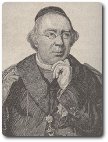Roman Catholicism
The Catholic remnant
England had ceased to be a Roman Catholic country three centuries earlier in the Reformation under Henry VIII, and from then on saw itself as essentially Protestant. But certain parts of England had always had a few diehard Catholics, especially in:
- the North West
- Ireland, which had remained largely Catholic, though Protestants had been brought in to settle the northern counties in the seventeenth century
- Scotland, where certain Highland areas had remained Catholic.
The re-establishment of a Catholic Church
There was no properly organized Church structure for Catholics (outside of Ireland). However, by the mid-nineteenth century, the number of Catholics in Britain was increasing:
number of Catholics in Britain was increasing:
- large numbers of Irish had come into England as it industrialized, partly to find work, partly to escape the famines at home
- refugees and immigrants from Europe were often Catholic.
The result was that in 1850, the Catholic Church decided to organize itself and set up a hierarchy in England. Cardinal Wiseman became its leading Archbishop at Westminster.
Reaction to Newman
Many English people looked on the resurgence of the Catholic Church as very threatening and as an attempt to take back lost ground. So when people of such calibre and ability as Newman converted, there was even more cause for alarm.
To show his approval of Newman's conversion, the Pope conferred a doctorate on him. There was no obstacle to Newman becoming a Catholic clergyman as he had never married (Catholic priests are required to be unmarried and celibate). Later, in 1879, he became a Cardinal in, and leader of, the Catholic Church in England and Wales.
Member of a worldwide Christian church which traces its origins from St. Peter, one of Jesus' original disciples. It has a continuous history from earliest Christianity.
Term given to the movements of church reform which in the sixteenth century resulted in new Protestant churches being created as an alternative to the Roman Catholic Church.
Christians whose faith and practice stems from the Reformation movement in the sixteenth century which resulted in new churches being created as an alternative to the Roman Catholic Church.
1. Term for a worshipping community of Christians.
2. The building in which Christians traditionally meet for worship.
3. The worldwide community of Christian believers.
A body of persons or things ranked in grades, orders, or classes. Used specifically of the 'Nine orders of angels'.
In the hierarchical structure of the Roman Catholic church, Cardinals represent the layer between Archbishops and the Pope. They are responsible for electing a new Pope, and they meet regularly with him in council.
The title given to the bishop who oversees the other bishops within his province.
1.To change from one faith or belief system to another; or from no faith to a faith.
2. Used in Christianity to describe the process of change in an individual who repents (turns from sin) and has faith in (turns towards) Jesus Christ.
The supreme governor of the Roman Catholic Church who has his headquarters in Rome, in Vatican City. In certain circumstances, his doctrinal utterances are deemed infallible.
Someone ordained as a priest, deacon or bishop to teach, conduct religious services, administer the sacraments and provide pastoral care within the Christian Church. Until recently, only men could be so ordained.
A person whose role is to carry out religious functions.
A commitment to remaining unmarried and abstaining from sexual intercourse. Required of monks and nuns, and of priests in the Roman Catholic church.
In the hierarchical structure of the Roman Catholic church, Cardinals represent the layer between Archbishops and the Pope. They are responsible for electing a new Pope, and they meet regularly with him in council.
 number of Catholics in Britain was increasing:
number of Catholics in Britain was increasing: